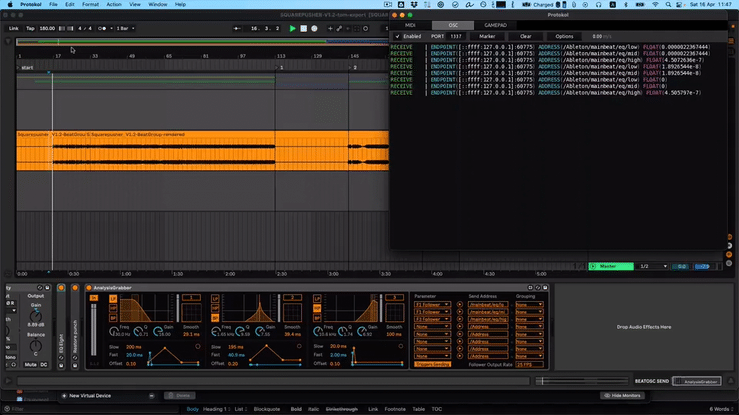Overview of used hardware
I will do a brief description of the hardware I used and which functions I programmed.
Launchpad X
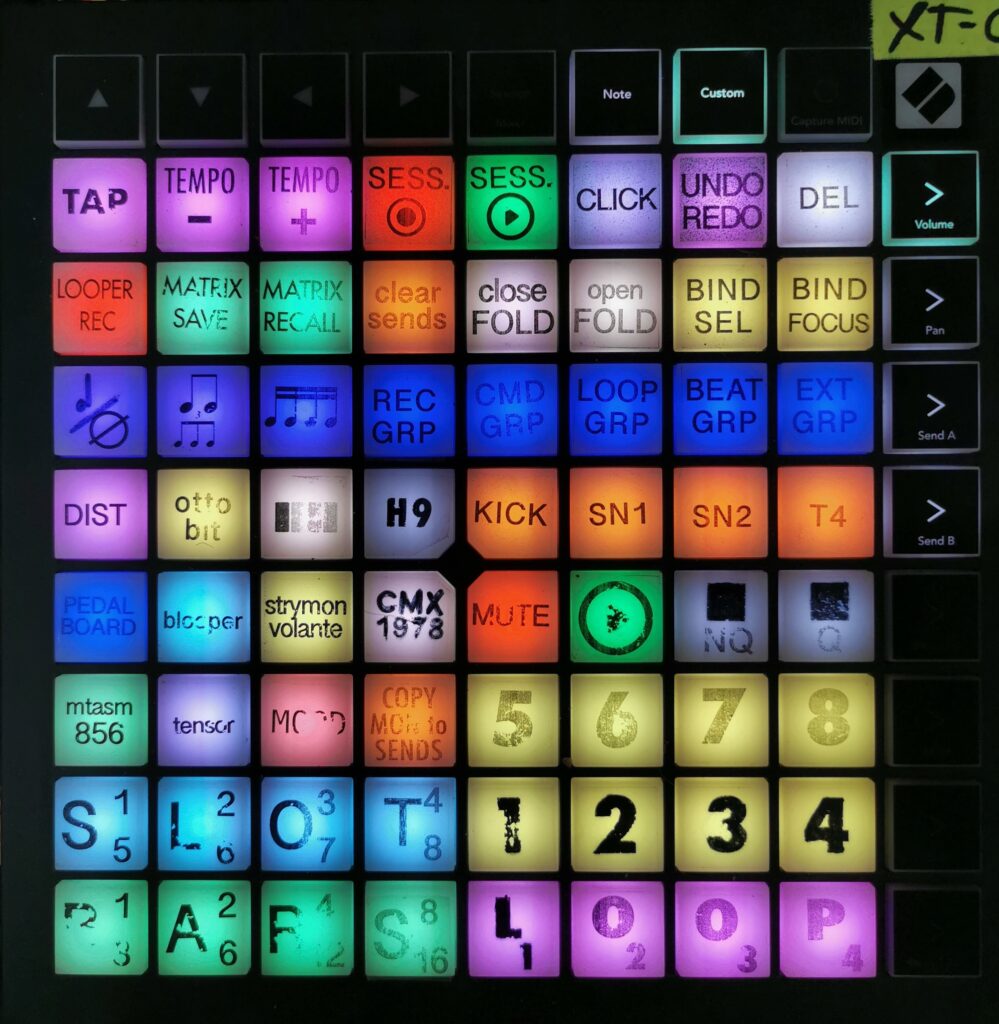
This is the center piece of my tableboard.
I described the use of buttons 1-8, SLOTS and Bars in the ClyphX Pro post under X-Modes.
In the middle row on the left are 11 buttons representing my effect pedals. I can send audio of focused or selected tracks in ABLETON LIVE. I have the same functionality implemented on my Midi Fighter Twister. On the launchpad mini I also have the same buttons. These 11 buttons will be re-mapped and dedicated to something else. This is also on my FUTURE PLANS list.
“COPY MON to SENDS” will copy the routing of what I actually hear on the selected recording track. I use this for dry recording. (described in more detail in my [THE MATRIX][matrixmixer] post.
“MUTE / PLAY / STOP NQ / STOP Q” – controls loop tracks 1-8 as well as the beat group or individual beat tracks like KICK or SNARE.
The 3 buttons in row 3 from the top on the left side set the quantisation applied after recording. At the moment, this applies only to played beats.
In the same row, the remaining 5 buttons represent my groups inside ableton.
“LOOPER REC” is for recording audio from ableton into one of my looper pedals on my tableboard.
“MATRIX SAVE / RECALL” is used together with buttons 1-8 to save my Matrix. This is not yet working to my satisfaction.
“clear sends” clears the sends inside ABLETON on the focused/selected track.
“close / open Fold” collapses or opens the view of a group (5 buttons below) to get a quick overview.
“BIND SEL / FOCUSED” locks the Midi Fighter Twister and many other controls to either the SELECTED track or to a locked(focused) track. e.g. I can change the focused track to loop track 2 by pressing holding button 2 for a longer period.
Upper Row:
“Tap TEMPO / – / +” sets the global tempo for live. When jamming this is a feature I use every time.
“Session record” records the session inside ABLETON
“Session play” – starts and stops ABLETON
“CLICK” turns on/off the click
“UNDO / REDO” – you guessed it: UNDO(short press) / REDO(long press)
“DEL” – deletes clips on tracks 1-8 (by pressing all each of them)
Launchpad mini mk3
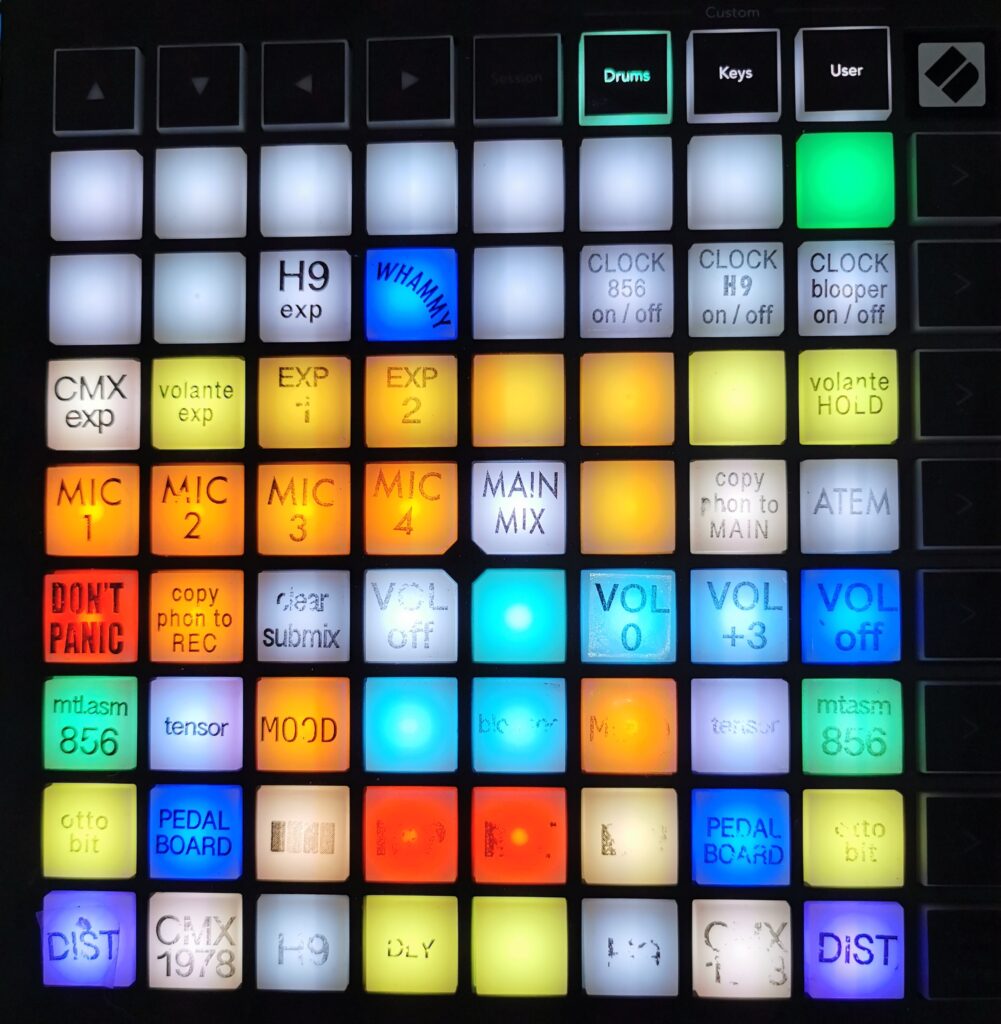
On the left, next to the Launchpad X is a smaller one.
This is used almost exclusively to control my matrix. The labels are worn at the moment and not finished yet.
I explained the use of the lower 3 rows extensively and in detail in my [THE MATRIX][matrixmixer] post.
There are some more buttons I will quickly describe:
“DON’T PANIC” – this button actually does nothing, but it gives me a safer feeling that it is there.
“copy phone to rec” – used for wet recording. copies what I hear to the recording bus.
“clear submix, VOL off, -3, 0, +3 db” are presets to set the volume of pressed source buttons
“MIC 1-4, MAIN MIX, ATEM etc” – represent more inputs (sources) and submixes. It is not stored properly in my matrix yet. I write about this in the [THE MATRIX][matrixmixer] post and it is on my FUTURE PLANS list to program properly. It works for now and I have to focus on the musical part of my master research. It has to wait for now.
Expression pedal matrix
“CMX exp, volante exp, EXP 1, etc.” these buttons represent 2 things:
- expression inputs of some of my pedals.
- expression pedals on the floor (4 of them inside the FCB1010)
I applied the same concept of [THE MATRIX][matrixmixer] to expression pedal assignments. As well as some predefined mappings available as presets.
Here are some labels I prepared and most of these functions are already programmed:
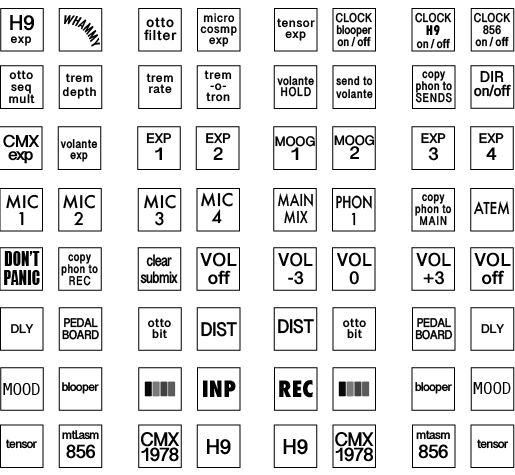
Midifighter Twister
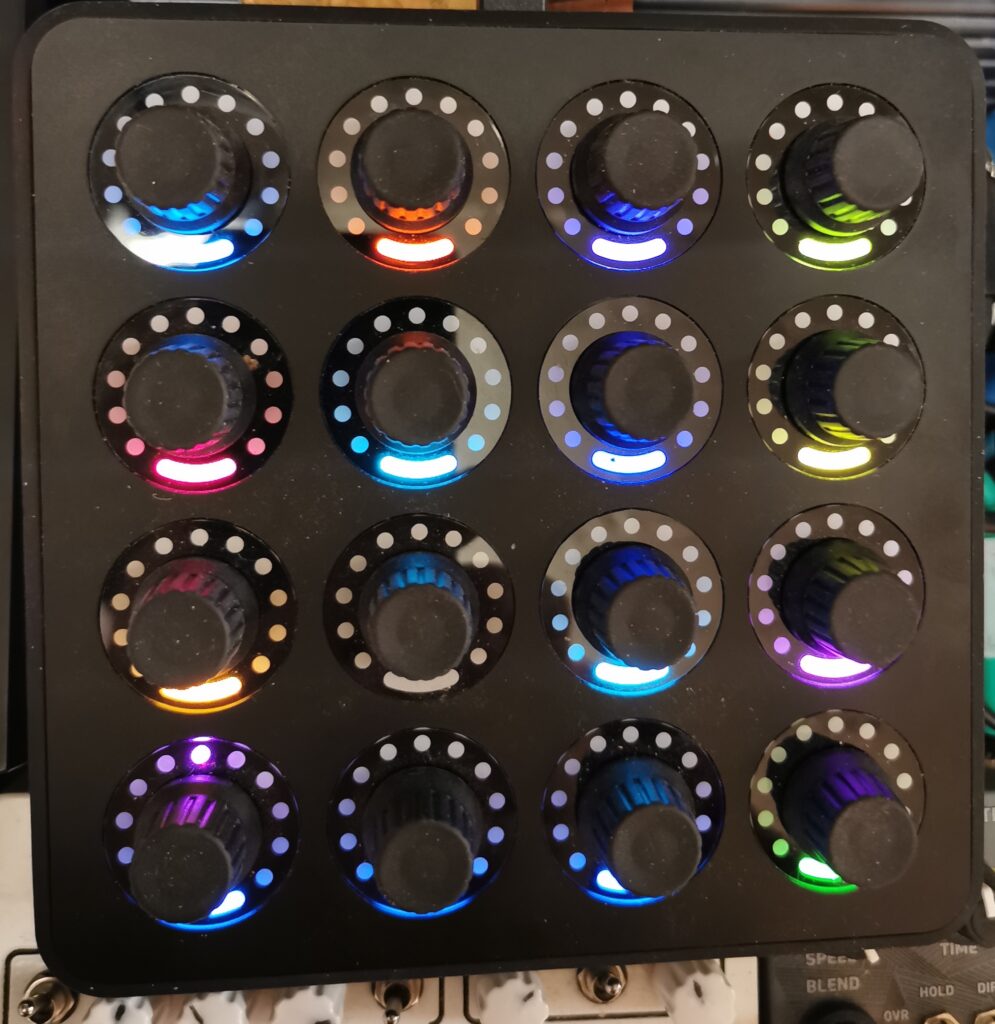
This unit has 4 programmable banks and RGB-coloured indicators. I use it mainly for:
- controlling sends (to effect pedals) of tracks in ABLETON
- controlling PAN of tracks
- controlling parameters in the eventide H9
- controlling parameters in devices/effects inside ABLETON like the TURNADO from SugarBytes.
I wrote a detailed post about the process of programming the Midi Fighter Twister.
Behringer BF2000 – motorised Fader Controller
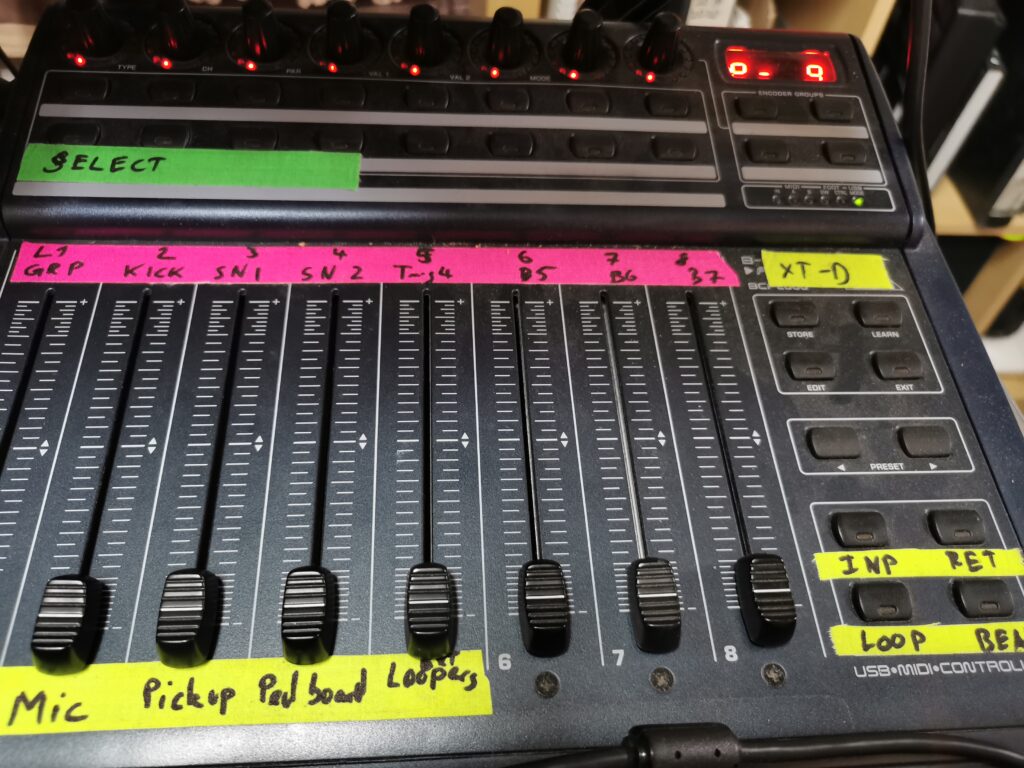
I had one of these lying around somewhere and integrated this at the very beginning when I started to build by setup.
The faders can be linked to the looptracks 1-8 (and 9-16) as well as the beat tracks (KICK, SNARE etc.). I like to use it because it is a intuitive representation of what is going on. and great for doing fade ins, fade outs, and doing more than one volume adjustment simultaneously.
Behringer FCB1010 Footcontroller
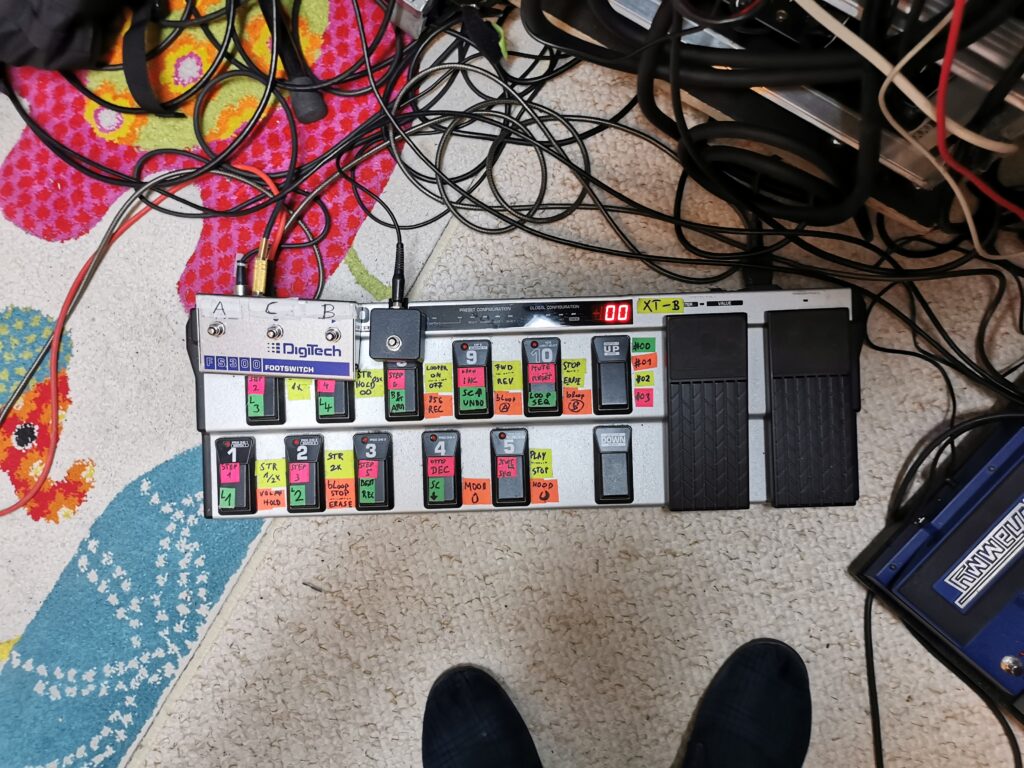
When I play the bass, both of my hands are busy. Because I need to give commands or trigger something at the same time, I have my feet left to operate things. I use an old foot controller from Behringer. This is a popular piece of gear, because it is sturdy, reliable and cheap.
Typical for Behringer the operation is not straight forward and possibilities are limited. Luckily, there are some nerds out there, which develop custom firmware chips to overcome these limitations.
I found a guy in Belgium who sells a chip with which I was able to configure my FCB1010 to my needs:
With this firmware I am able to use the buttons similar to a keyboard with a NOTE ON and NOTE OFF event. This enables me to program functions for short press, long press etc. ClyphX Pro G-Controls
I use it for:
- recording / stopping LOOP1-4
- ARMING / UNARMING drum sound triggers
- scrolling up & down through scenes
- trigger next scene
- recording a loop sequence
on other Banks I implemented functions for my pedals on the tableboard. As they are guitar pedals, they are designed to work as floor units. With MIDI I am able to access most of these functions remotely with my feet.
The other two smaller foot switches are connected to two pedals directly (TENSOR and blooper)
Already mentioned above, the FCB1010 has two expression pedals which are very useful to control parameters gradually while playing to enhance the expression.
Typical use case is the amount of reverb or the length of a delay line.
What is better than one foot controller? two foot controllers! To keep it simple, both are mapped exactly the same (except the expression pedals) so I can access two banks at the same time.
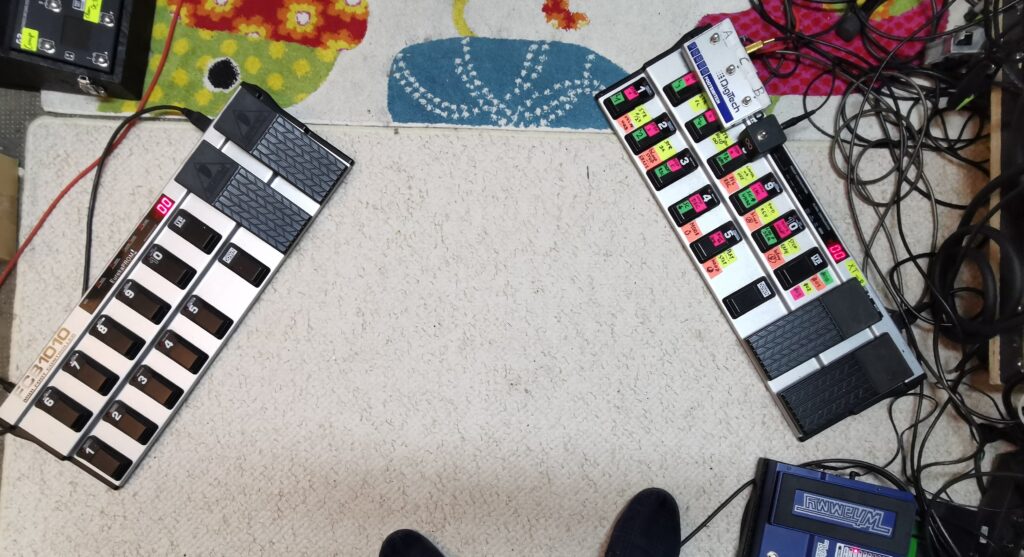
other hardware used:
without further detailed explanation
- RME Fireface 802 – Audio interface
- 2x Behringer AD8000 – Audio converter (analog/digital)
- Samson S-Patch
- UAD 2-610 Preamp
- acer display
- ddrum trigger converter (audio trigger to MIDI)
Pedals:
Pedalboard for the doublebass pickup:
- Boss OC-2
- Audio Sprockets Tone Dexter
- Digitech Bass Whammy
- Stone Deaf – Fig Dumb
tableboard:
- ottobit jr. – MERIS (bitcrusher and sequencer)
- Tensor – Red Panda Labs (looper/sample manipulation)
- count to five – montreal assembly (looper/sample manipulation)
- 856zellersasn – montreal assembly (looper/sample manipulation)
- MOOD – chase bliss audio (micro looper)
- BLOOPER – chase bliss audio (bottomless looper)
- microcosm – HOLOGRAM ELECTRICS (looper/sample manipulation)
- CMX 1978 – chase bliss audio (reverb)
- Volante – strymon (delay emulation)
- H9 – eventide (multieffect, mainly used for pitch shift effects)
- DualDagger – Shakmat (custom modular rack)
- 3 USB hubs
- Power supply units
- MIDI Interface
- MIDI utility converters
- MANY, MANY patchcables.
Summary
- This collection of hardware evolved over time. With ClyphX Pro it is possible to link all of the controllers and lift borders in between them. It feels to me that I have only just begun using a part of the potential. The more time I spend with the setup, the more familiar I get with it.




